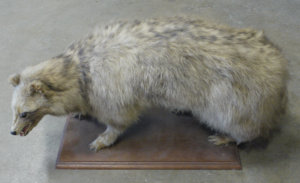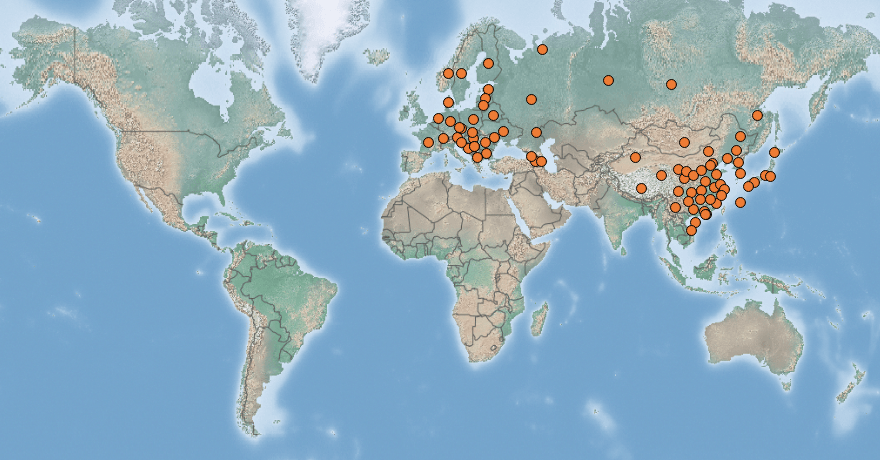 |
Raccoon dog | Status LU: casual. First record: 2021. |
 |
Marderhond1 | Status Eur.: established. IAS of EU concern (2017). |
 |
Chien viverrin | RA: ISEIA: C1. Harmonia+: n/a. |
 |
Marderhund | Wikipedia: |
 |
Wasbeerhond | Back to the list of vertebrates |
Contents
Report the species
→ Report Nyctereutes procyonoides to the National Museum of Natural History.
Brief description
Nyctereutes procyonoides (Gray, 1834) often lives near water and prefers moist deciduous or mixed forests with abundant undergrowth. It may also occur in wetlands and in a mosaic of woodlands and agricultural areas. The raccoon dog is an opportunistic omnivore with a very wide food niche and is an excellent disperser. It has been reported to cause severe damage to amphibians, waterfowl colonies and tetraonid birds and may compete with native species such as red foxes and badgers.
The raccoon dog is a small canine species (weighing 3-7 kg) originally from East Asia. Between 1929 and 1955, about 9,000 raccoon dogs were released for hunting purposes in the European part of Russia and Ukraine. From there, the species spread rapidly westwards (Naturverwaltung, 2021).
IAS of Union concern
In 2017, Nyctereutes procyonoides (Gray, 1834) was added to the list of invasive alien species of Union concern (Anonymous, 2017) which implies that member states shall take all necessary steps to prevent its unintentional introduction or spread.
Status and distribution in Luxembourg
Records of Nyctereutes procyonoides (Gray, 1834) in Luxembourg. Data source: Recorder-Lux, iNaturalist & GBIF, 2025-12-31.
On 2021-02-03, a raccoon dog was officially recorded for the first time in Luxembourg, in Bettembourg (Naturverwaltung 2021, Schley et al 2021). It can be assumed that the raccoon dog has been sporadically present in the country for a long time; however, as the species is very discreet, it is often not detected for a long time. In recent years, the nature and forest administration has received several indications of raccoon dogs, which, however, were mostly unverifiable (Naturverwaltung 2012). In the few cases where photos or even roadkill were available, it was always a badger or raccoon; for the layman, the latter especially looks very similar to the raccoon dog at first sight. In Luxembourg, according to the 2011 hunting law, the raccoon dog may be hunted all year round – with the exception of the 6-week hunting rest period from 1 March to 15 April.
Risk assessment
ISEIA protocol
Following its first confirmed record in Luxembourg on 2021-02-03, the species has been reassessed on 2021-03-12 to C1 (3+3+1+1) by Manou Pfeiffenschneider & Christian Ries. Assessment before the appearance of the species in Luxembourg: C0 (3+3+1+1) (Ries et al. 2014: 199).
Harmonia+ protocol
Not assessed yet.
Worldwide distribution
Bibliography
- Anonymous, 2017. Commission implementing regulation (EU) 2017/1263 of 12 July 2017 updating the list of invasive alien species of Union concern established by Implementing Regulation (EU) 2016/1141 pursuant to Regulation (EU) No 1143/2014 of the European Parliament and of the Council. Official Journal of the European Union L 182: 37-39 (13.7.2017).
- CABI, 2019. Nyctereutes procyonoides (Gray, 1834). In: Invasive Species Compendium. Wallingford, UK: CAB International. URL: www.cabi.org/isc [accessed 2020-04-22]
- Hagen, S., 2021. E Marderhond zu Lëtzebuerg. De Panewippchen 134 (1/2021): 15.
- Kirsch, E., K. Klein, L. Bonblet, M. Weishaar, T. Duscher, T. De Sousa & M. Jacobs, 2021. Waschbären & Marderhunde in Luxemburg. 48 S. Hrsg.: Administration de la nature et des forêts (ANF) & Musée national d’histoire naturelle (MNHNL). [PDF >5 MB]
- MNHNL, iNaturalist & GBIF, 2019. MNHNL-mdata, online portal combining species observation from Recorder-Lux, iNaturalist and GBIF. National Museum of Natural History, Luxembourg. URL: https://mdata.mnhn.lu [Accessed 2019-10-25]
- Naturverwaltung (ed.), 2012. Technischer Bericht der Naturverwaltung betreffend Wildtiermanagement und Jagd, Nummer 2 (2012), 68 pp.
- Naturverwaltung (ed.), 2013. Jagbare Wildtierarten Luxemburgs. 96 pp.
- Naturverwaltung, 2021. Marderhund erstmals in Luxemburg nachgewiesen (08.02.2021). Communiqué de presse par courriel du Service information et presse du gouvernement luxembourgeois.
- Ries, C., M. Pfeiffenschneider, Engel, E., J.-C. Heidt & M. Lauff, 2014. Environmental impact assessment and black, watch and alert list classification after the ISEIA Protocol of vertebrates in Luxembourg. Bull. Soc. Nat. luxemb. 115: 195-201. [PDF 247 KB]
- Schley, L., C. Schanck, M. Schaul & C. Sinner, 2001. Neubürger und Heimkehrer unter den Wildtieren Luxemburgs. Beiträge zur Jagd- und Wildforschung 26: 141-154.
- Schley L., M. Jacobs, T. De Sousa & J. Hatlauf, 2021. First record of the raccoon dog Nyctereutes procyonoides (Gray, 1834) in Luxembourg. Belgian Journal of Zoology 151: 57–61. https://doi.org/10.26496/bjz.2021.85
- Schley, L. & J. Herr, 2018. Säugetiere Luxemburgs. Natur&ëmwelt, Ministère du Développement durable et des Infrastructures & Administration de la nature et des forêts, Luxembourg, 220 p.
- Wörterbuchkommission (Hrsg.), 1987. Luxemburger Wörterbuch. 5 Bd. Im Auftrag der Grossherzoglichen Luxemburgischen Regierung. Linden, Luxemburg.
Suggested citation of this webpage
Ries, C. & M. Pfeiffenschneider (Eds.), 2025. Nyctereutes procyonoides (Gray, 1834). In: neobiota.lu - Invasive Alien Species in Luxembourg. National Museum of Natural History, Luxembourg. URL: https://neobiota.lu/nyctereutes-procyonoides/ [Accessed 2025-12-31].
Page content last updated on 2022-02-18. Last proofread by Caroline Grounds on 2021-02-09.
- The actual common name for martens is “Marder” (Schley & Herr 2018) → “Marderhond”. An outdated name, occasionally used by older people, is “Mardéier” (Wörterbuchkommission 1987) → “Mardéierhond”.[↩]



